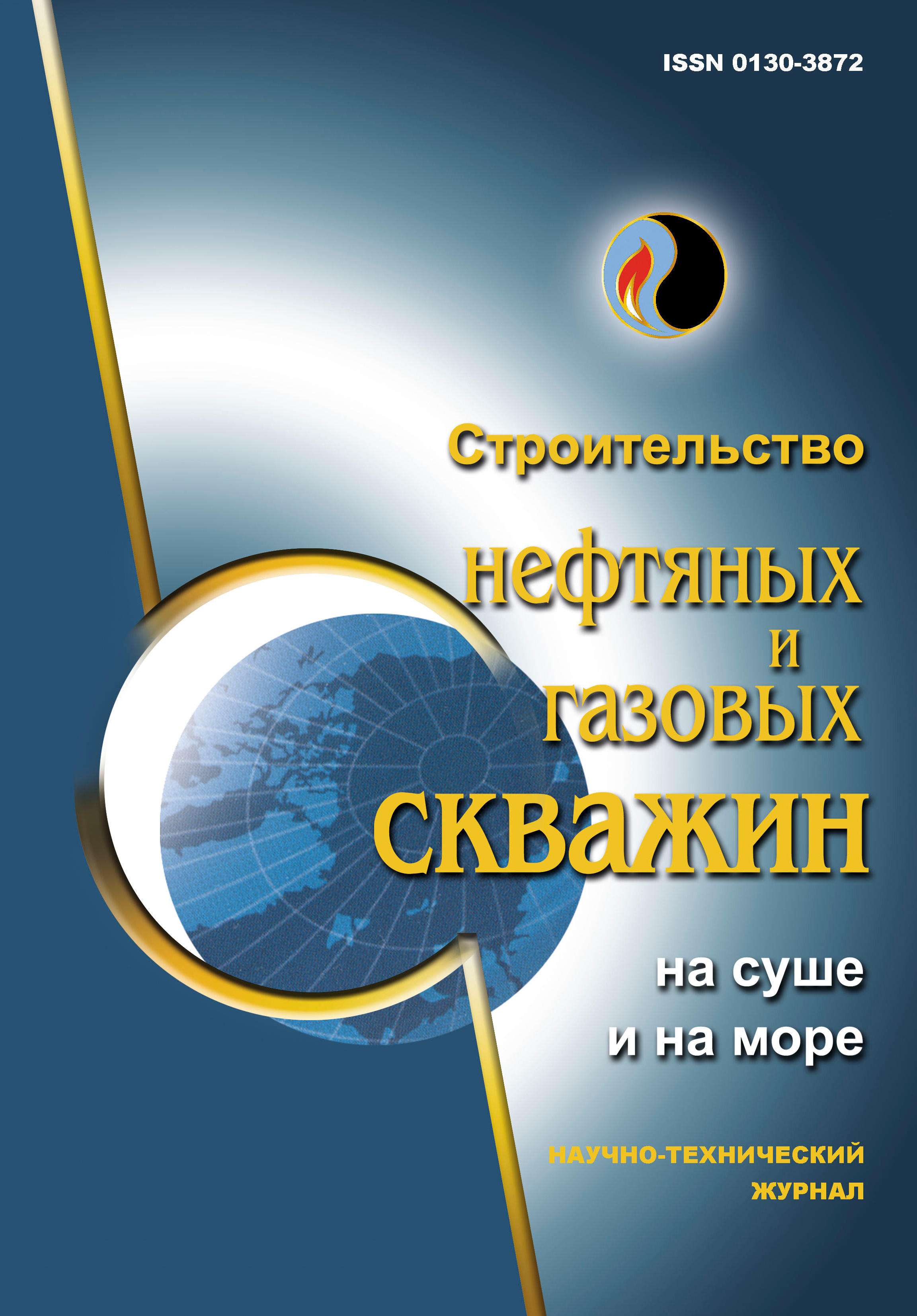Научно-технический журнал
«Onshore and offshore oil and gas well construction»
ISSN 0130-3872

To the problem of the inhibiting and fixing ability of the polymercationic drilling fluid
UDC: 622.276.66
DOI: 10.33285/0130-3872-2023-10(370)-25-33
Authors:
1 Gazprom VNIIGAZ, St. Petersburg, Russia
2 Asia Petro Service, Aktau, Kazakhstan
3 Gazprom Marine Projects, Krasnoyarsk, Russia
4 Schlumberger Technology Company, Tyumen, Russia
Keywords: wells construction, shale inhibition, clay capacity, wellbore stability, drilling fluids, complications, polymer cationic fluids
Annotation:
Difficult geological and technical conditions of drilling to a large extent hold back the pace of wells construction. The interaction of the drilling fluid with drilled out clay rock manifests itself in the form of hydration, swelling and dispersion of clay under the influence of physicochemical and thermobaric processes. During well construction, clay sludge negatively impacts the drilling fluidbehavior, causing the MBT increase, as a result of which its rheological parameters increase. To reduce the negative impact of clay cuttings on the drilling fluidproperties, inhibitory solutions are used. In field practice, the inhibitory ability of a drilling fluid is often determined by the clay capacity. It is known that the more effective the thinner and the greater its amount are, the higher is the clay capacity of the solution. Therefore, in such a system, liquefaction occurs by the mechanism of dispersing clay to a clay fraction and reducing coagulation. While drilling shale intervals, at some point the MBT will start to increase ahead of time and the dilution (or thinning) efficiency will become very low. All this leads to an increase of the colloidal fraction index and rheology proportional increase, the reduction of which requires periodic dilution of the solution by a dispersion medium. The use of high-viscous polymercationic drilling fluids in clay deposits of Astrakhan gas condensate field provided averagelya 2-3 times increase of the drilling mechanical speed, prevented the operating time and associated disposal of the fluid, reduced complications, ensured stable technological parameters and minimized chemical treatments. In this regard, the team of the authors and "Gazprom VNIIGAZ" LLC recommend the use of polymercationic drilling fluids with high inhibitory and fixing properties for wells construction at the gas condensate field, and the use of the operating time as a criterion for assessing the inhibitory ability. Fluid operational life-time is the main criterion for the inhibitory ability of a drilling fluid in field conditions. Despite the positive experience of using potassium chloride in the composition of inhibiting drilling fluids, it was proved that its content distorts geophysical information. The disadvantages of the sodium chloride modification of the polymer cationic solution are the low fixing ability, first of all, in relation to argillite-like clayey rocks of the Permian-Triassic. Based on the studies carried out, polymercationic solutions with sodium nitrate have been developed. The developed polymer cationic solutions demonstrated a higher fixing ability in relation to unstable argillite-like clayey rocks of the Permian-Triassic.
Bibliography:
1. O vybore reologicheskikh pokazateley burovogo rastvora / A.M. Gaydarov, A.A. Khubbatov, D.V. Izyumchenko [i dr.] // Stroitel'stvo neftyanykh i gazovykh skvazhin na sushe i na more. – 2021. – № 4(340). – S. 19–24. – DOI: 10.33285/0130-3872-2021-4(340)-19-242. Gaydarov A.M. Issledovanie i razrabotka polimerkationnykh rastvorov dlya stroitel'stva skvazhin v slozhnykh gorno-geologicheskikh usloviyakh: dis. … kand. tekhn. nauk: 2.8.2. – Ufa, 2023. – 210 s.
3. Kister E.G. Khimicheskaya obrabotka burovykh rastvorov. – M.: Nedra, 1972. – 392 s.
4. Ryazanov Ya.A. Spravochnik po burovym rastvoram. – M.: Nedra, 1979. – 215 s.
5. Tekhnologiya provodki podsolevykh skvazhin v Prikaspiyskoy vpadine / pod red. U.S. Karabalina, M.A. Tankibaeva. – M.: Nedra, 1989. – 161 s.
6. Geologiya i neftegazonosnost' zapadnoy chasti Prikaspiyskoy vpadiny / T.N. Dzhumagaliev, B.G. Moysik, S.U. Utegaliev, V.F. Poplevin; pod red. T.N. Dzhumagalieva. – M.: Nedra, 1970. – 176 s.
7. Pat. 2798347 Ros. Federatsiya, MPK C09K 8/24, C09K 8/12, E21B 7/00. Psevdoplastichnyy burovoy rastvor dlya uluchsheniya ochistki stvola skvazhiny i sposob bureniya s ego primeneniem (varianty) / A.M. Gaydarov, A.A. Khubbatov, M.M.-R. Gaydarov [i dr.]; patentoobladatel' OOO "Gazprom VNIIGAZ". – № 2022108143; zayavl. 28.03.2022; opubl. 21.06.2023, Byul. № 18.
8. Gruntovedenie: 6-e izd., pererab. i dop. / V.T. Trofimov, V.A. Korolev, E.A. Voznesenskiy [i dr.]; pod red. V.T. Trofimova. – M.: MGU, 2005. – 1024 s.
9. Ustoychivost' glinistykh porod pri stroitel'stve skvazhin: obzornaya inform. / M.M.-R. Gaydarov, D.G. Bel'skiy, D.V. Izyumchenko [i dr.]. – M.: Gazprom VNIIGAZ, 2014. – 99 s.
10. Osobennosti formirovaniya suprastruktur v burovykh rastvorakh / M.M.-R. Gaydarov, A.D. Norov, V.V. Golovin, A.A. Khubbatov // Stroitel'stvo neftyanykh i gazovykh skvazhin na sushe i na more. – 2012. – № 6. – S. 38–42.
11. Polikationnye burovye rastvory "Katburr" i perspektivy ikh ispol'zovaniya / M.M.-R. Gaydarov, A.A. Khubbatov, A.M. Gaydarov [i dr.] // Stroitel'stvo neftyanykh i gazovykh skvazhin na sushe i na more. – 2019. – № 7. – S. 19–25. – DOI: 10.30713/0130-3872-2019-7-19-25
12. Rekomendatsii po otsenke ingibiruyushchikh i krepyashchikh svoystv burovogo rastvora / M.M.-R. Gaydarov, A.A. Khubbatov, A.M. Gaydarov [i dr.] // Heft. khoz-vo. – 2019. – № 2. – S. 33–38. – DOI: 10.24887/0028-2448-2019-2-33-38
13. Dedusenko G.Ya., Ivannikov V.I., Lipkes M.I. Burovye rastvory s malym soderzhaniem tverdoy fazy. – M.: Nedra, 1985. – 160 s.